 |
 |
 |
| |
Tenofovir & Renal Dysfunction
|
| |
| |
Reported by Jules Levin
Certain risk factors are associated with kidney dysfunction in general and they include diabetes and hypertension, and being African-American, not uncommon among HIV+ individuals so check and evaluate patient’s risk factors. MDRD can be useful for evaluation. It is recommended to monitor labatorary values every few months if taking tenofovir.

OBJECTIVE: Evaluate the safety profile of TDF for the treatment of HIV infection as observed in:
--Viread Global EAP
--Spontaneous safety reports submitted to Gilead through the first 4 years following commercial availability
METHODS
Viread Global EAP
-- A total of 10,343 patients were enrolled
-- Some SAE data are available for all patients
-- Serum creatinine was collected in over 1,600 patients
-- Risk factors for development of graded creatinine abnormalities were determined using ultivariate logistic regression models
Post marketing safety data
-- ADRs received through spontaneous reporting up to April 30, 2005 have been collected & analyzed
-- Based upon an estimated 455,392 patient-years of exposure to TDF (estimated from sales data)
Results: Serious Renal Adverse Event Categories
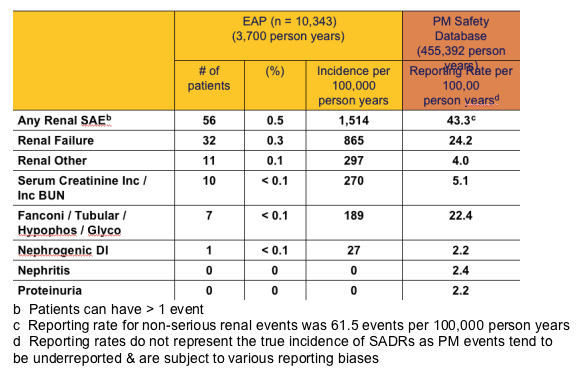
"Efficacy and Safety of Tenofovir DF
vs Stavudine in Combination Therapy
in Antiretroviral-Naive Patients"
A 3-Year Randomized Trial
Excerpts from the JAMA publication of this well-known Gilead tenofovir study (JAMA July 2004).
......study entry criteria: Patients were required to have adequate hematologic (absolute neutrophil count >/= 1000/_L, >/= platelets 50 103/_L, hemoglobin >/= 8.0 g/dL), hepatic (transaminases /= 60 mL/min [>/= 1.00 mL/s]).....
..... At week 144, a greater mean percentage decrease from baseline in bone mineral density was observed at the lumbar spine in the tenofovir DF group
(_2.2% tenofovir DF vs _1.0% stavudine, P=.001) but similar changes were
observed at the hip (_2.8% tenofovir DF vs _2.4% stavudine, P=.06). Notably,
these decreases occurred through weeks 24 to 48 and stabilized through week
144 (FIGURE 3, see below). Sixteen patients (11 in the stavudine group and 5 in the tenofovir DF group) developed bone fractures through 144 weeks. Nearly all
fractures were related to trauma, except for a vertebral compression fracture
for 1 patient in the stavudine group. Through 144 weeks, the renal safety
profile was similar between the 2 groups (TABLE 5, see below). Two patients in each group developed a creatinine level of more than 2.0 mg/dL (>176.8 _mol/L), while hypophosphatemia (<2.0 mg/dL [<176.8 _mol/L]) was observed in 10
patients receiving tenofovir DF and 8 patients receiving stavudine. The incidence
of proteinuria and/or glycosuria was similar between the two groups.No
patient developed Fanconi syndrome or discontinued from study due to tenofovir
DF–related renal abnormalities. The renal safety profile associated with
these drugs is addressed in more detail in other analyses.36.....
..... Although decreased bone mineral density and nephrotoxicity have been
observed in experiments with monkeys receiving high doses of subcutaneous
tenofovir, in this 3-year trial decreases in bone mineral density were small and largely nonprogressive but significantly greater in the tenofovir DF group at the lumbar spine but not at the hip. There have been case reports of renal
toxicity in patients with antiretroviral regimens containing tenofovir DF.41-43 However, through 3 years in this study in patients with normal renal function at baseline, the renal safety profile was similar between the tenofovir DF and stavudine groups......
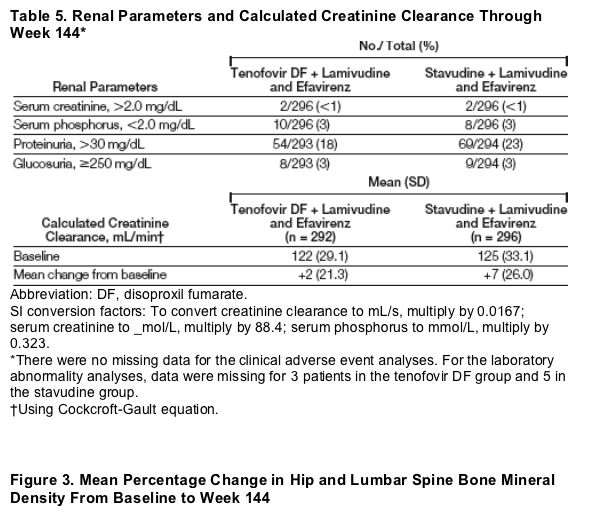
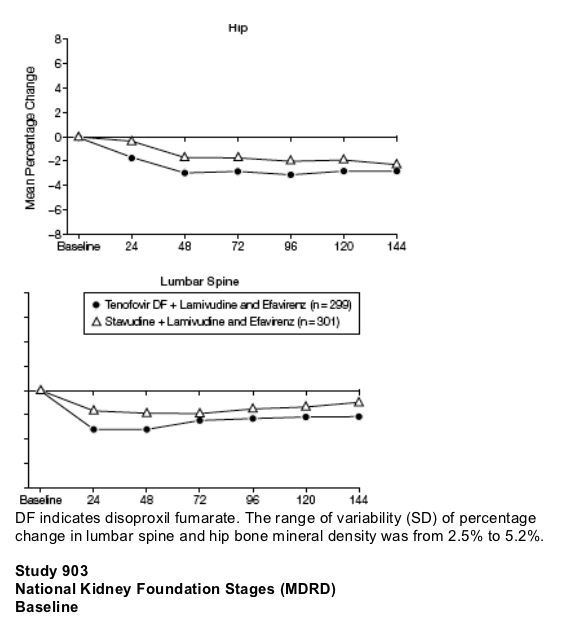
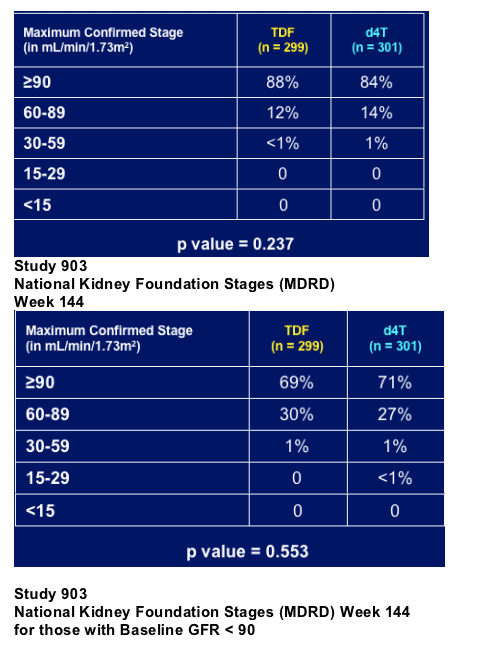
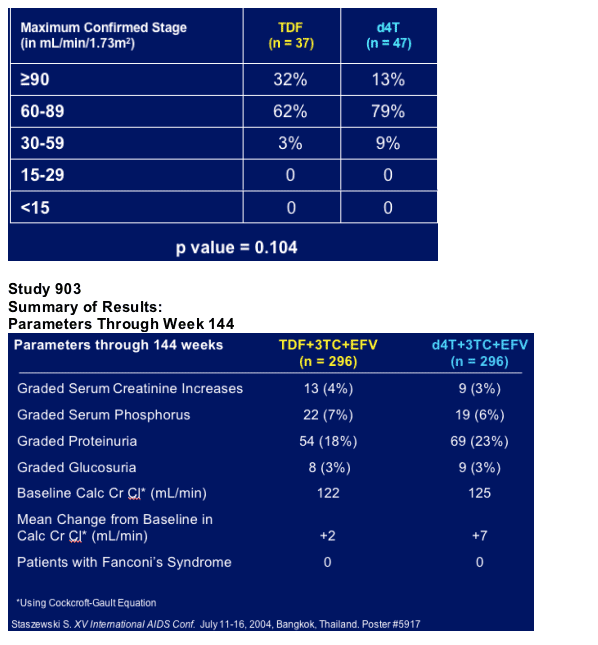
ABSTRACT
Context: Tenofovir disoproxil fumarate (DF) is a once-daily nucleotide analogue reverse transcriptase inhibitor.
Objective: To evaluate the efficacy and safety of tenofovir DF compared with stavudine in antiretroviral-naive patients.
Design, Setting, and Participants: A prospective, randomized, double-blind study conducted at 81 centers in the United States, South America, and Europe from June 9, 2000, to January 30, 2004. A total of 753 patients infected with HIV who were antiretroviral naive were screened and 602 patients entered the study.
Intervention: Patients were randomized to receive either tenofovir DF (n=299) or
stavudine (n=303), with placebo, in combination with lamivudine and efavirenz.
Main OutcomeMeasure: Proportion of patients with HIV RNA levels of less than
400 copies/mL at week 48.
Results: In the primary intent-to-treat analysis in which patients with missing data or who added or switched antiretroviral medications before week 48 were considered as failures, the proportion of patients with HIV RNA of less than 400
copies/mL at week 48 was 239 (80%) of 299 in patients receiving tenofovir DF and 253 (84%) of 301 in patients receiving stavudine (95% confidence interval,
_10.4% to 1.5%), exceeding the predefined _10% limit for equivalence. However,
equivalence was demonstrated in the secondary analyses (HIV RNA <50 copies/
mL) at week 48 and through 144 weeks. Virologic failure was associated most frequently with efavirenz and lamivudine resistance. Through 144 weeks, the K65R mutation emerged in 8 and 2 patients in the tenofovir DF and stavudine groups, respectively (P=.06). A more favorable mean change from baseline in fasting lipid profile was noted in the tenofovir DF group at week 144: for triglyceride levels (+1 mg/dL for tenofovir DF [n=170] vs +134 mg/dL for stavudine [n=162], P .001), total cholesterol (+30 mg/dL [n=170] vs +58 mg/dL [n=162], P .001), direct lowdensity lipoprotein cholesterol (+14 mg/dL [n=169] vs +26 mg/dL [n=161], P .001), and high-density lipoprotein cholesterol (+9 mg/dL [n=168] vs +6 mg/dL [n=154], P=.003). Investigator-reported lipodystrophy was less common in the tenofovir DF group compared with the stavudine group (9 [3%] of 299 vs 58 [19%] of 301, P .001). The number of bone fractures and the renal safety profile were similar between the 2 groups.
Conclusions: Through 144 weeks, the combination of tenofovir DF, lamivudine, and efavirenz was highly effective and comparable with stavudine, lamivudine, and efavirenz in antiretroviral-naive patients. However, tenofovir DF appeared to be associated with better lipid profiles and less lipodystrophy.
JAMA. 2004;292:191-201
|
|
| |
| |
|
 |
 |
|
|